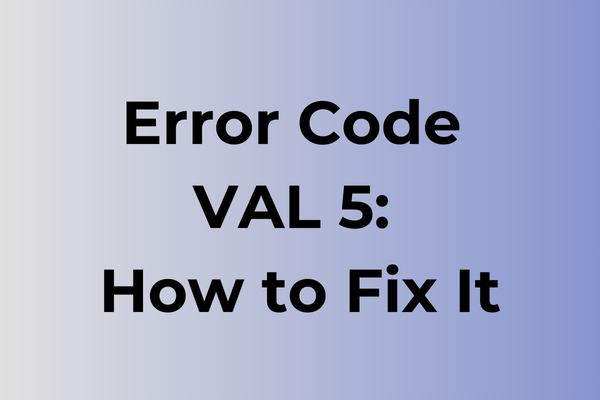When a system crashes with Error Code VAL 5, it disrupts critical operations and leaves users scrambling for answers. This validation error typically emerges during software installations or system updates, creating a ripple effect that impacts productivity and data integrity. The complexity of VAL 5 stems from its multiple potential triggers, ranging from corrupted registry entries to incompatible system configurations. This guide explores the root causes behind Error Code VAL 5 and presents several proven solutions, from basic troubleshooting steps to advanced recovery methods, ensuring systems return to optimal functionality.
What Is Error Code VAL 5
Gaming frustrations can strike at the most unexpected moments. Error Code VAL 5 is a persistent connectivity issue that appears in Valorant, Riot Games’ popular tactical shooter. This error typically manifests as a client connection problem, preventing players from accessing the game’s servers and effectively blocking them from joining matches or even launching the game. When encountered, players are met with a distinctive error message indicating that their connection to the Valorant service has failed. The error creates a particularly disruptive experience as it completely halts gameplay attempts, leaving players unable to participate in competitive matches or casual games. While the error message itself may seem cryptic, it’s essentially a signal that the game client cannot establish a stable connection with Valorant’s servers.
In the next part of this article, we will explore the effective methods to resolve Error Code VAL 5 and get back into the action.
How To Fix Error Code VAL 5
Error Code VAL 5 often disrupts smooth functionality, but there are effective methods to resolve it. Here are some of the most popular solutions that can help restore normalcy.
1. Check Internet Connection:
A stable internet connection is crucial for seamless operation. Start by ensuring that the device is connected to a reliable network. Restart the router if necessary and run a speed test to confirm that the connection meets the required standards for performance.
2. Update the Application:
Outdated software can lead to compatibility issues. Check for updates for the application or platform experiencing the error. Most applications have an automatic update feature, but manually checking in the settings can ensure that the latest version is installed.
3. Clear Cache and Data:
Accumulated cache and data can interfere with application performance. Navigate to the settings of the device, find the application in question, and select the option to clear cache and data. This can often resolve unexpected errors by refreshing the app’s stored information.
4. Reinstall the Application:
If clearing the cache does not resolve the issue, a complete reinstallation may be necessary. Uninstall the application from the device, then visit the app store to download and install it again. This process can eliminate any corrupted files that may be causing the error.
5. Check for System Updates:
System updates can also play a crucial role in app performance. Go to the device settings and check for any pending system updates. Installing these updates can improve compatibility with various applications and fix underlying issues.
6. Disable VPN or Proxy:
Using a VPN or proxy can sometimes lead to connectivity problems. Temporarily disable these services to see if the error persists. If the error is resolved, consider adjusting the settings of the VPN or switching to a different server.
7. Contact Support:
If all else fails, reaching out to customer support for the application or platform may provide specific guidance tailored to the issue. Providing detailed information about the error can help support staff diagnose and resolve the problem more effectively.
By following these steps, the path to resolving Error Code VAL 5 can be navigated with greater ease, restoring functionality and enhancing the overall user experience.
What is causing error code val 5?
Network congestion stands as a primary trigger for the notorious error code val 5, creating bottlenecks in data transmission. Outdated graphics drivers frequently contribute to this issue, preventing proper communication between hardware components. Server-side problems at the application level can disrupt the connection sequence, leading to this specific error code.
Corrupted game files or incomplete installations often manifest as val 5 errors, particularly when essential components fail to sync properly. Background applications consuming excessive bandwidth may interfere with the main program’s connectivity, resulting in this error code. Firewall settings and security software can inadvertently block necessary connections, triggering the val 5 response.
System memory limitations sometimes create conditions where applications cannot establish stable connections, producing this error. Temporary network fluctuations, especially during peak usage hours, may cause momentary disconnections that generate val 5 alerts. Router configuration mismatches between client and server protocols can also lead to this specific error code. DNS cache conflicts occasionally disrupt the proper resolution of server addresses, manifesting as val 5 errors during connection attempts.
FAQ
Q: What does error code VAL 5 mean?
A: Error code VAL 5 typically indicates a validation failure in the system’s data processing. This occurs when input data doesn’t meet the required format or parameters specified in the validation rules.
Q: How can I fix error code VAL 5?
A: To resolve VAL 5, first check your input data for special characters, incorrect formatting, or missing required fields. Clear your cache and temporary files, then retry the operation. If the problem persists, verify that your software version is up to date and compatible with the system requirements.
Q: Is error code VAL 5 a serious issue?
A: While VAL 5 can be frustrating, it’s not typically a severe system error. It’s a protective measure that prevents invalid data from being processed, which helps maintain data integrity. However, if you encounter this error frequently, it may indicate a deeper issue with your data entry process or system configuration that should be addressed by your IT support team.
